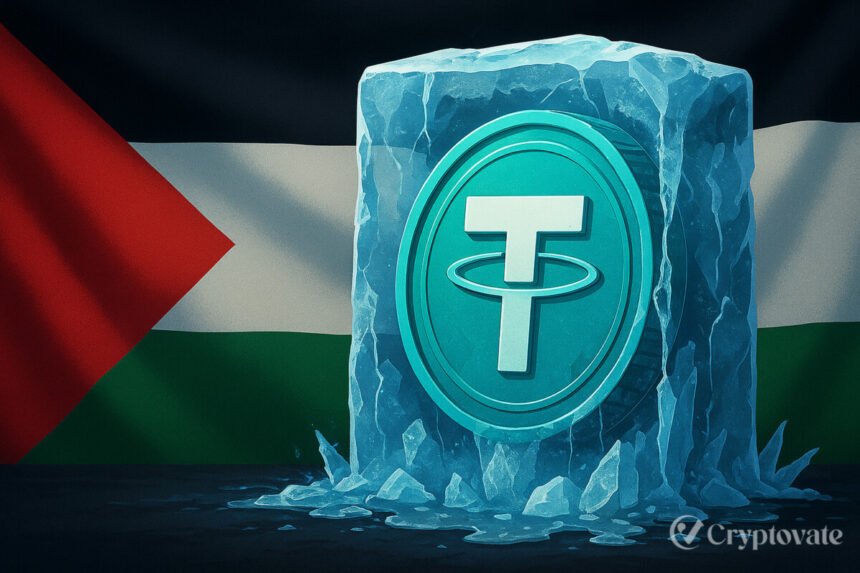– Ad –
| Getting your Trinity Audio player ready... |
On July 24, 2025, Tether USDT, the world’s largest stablecoin by market capitalization, froze $1.6 million in funds tied to a Palestinian payment network. This action, executed in collaboration with the U.S. Department of Justice (DOJ), has sparked widespread discussion about stablecoin regulation and the role of crypto compliance in the digital asset ecosystem. As stablecoins like Tether USDT become integral to global finance, this incident underscores the growing tension between regulatory oversight and the principles of decentralized finance.
The freeze highlights how stablecoin issuers are navigating an increasingly complex regulatory landscape. With governments worldwide scrutinizing digital currencies, Tether’s proactive measures signal a pivotal moment for stablecoin regulation and its alignment with traditional financial systems.
Tether and DOJ Target Terrorism Financing
The frozen $1.6 million in Tether USDT was linked to Buy Cash Money and Money Transfer Company (BuyCash), a Gaza-based financial network allegedly involved in terrorism financing. The DOJ, leveraging blockchain transparency, coordinated with Tether to trace and block the implicated wallets as part of a broader civil forfeiture case. Tether swiftly reissued the frozen funds to clean addresses, ensuring minimal disruption to legitimate users while reinforcing its commitment to combating illicit activity.
To date, Tether has frozen over $2.9 billion in USDT across more than 5,000 wallets, often in partnership with global law enforcement. This latest action demonstrates how blockchain transparency enables real-time tracking of transactions, allowing stablecoin issuers to respond decisively to suspicious activities. However, it also raises questions about the extent of centralized control in a technology rooted in decentralization.
Balancing Decentralized Finance and Regulatory Oversight
Tether’s wallet-freezing capability underscores a fundamental difference between stablecoins and permissionless cryptocurrencies such as Bitcoin or Ethereum. Unlike truly decentralized systems, Tether USDT operates with centralized oversight, enabling rapid responses to regulatory demands but challenging the ethos of decentralized finance. This incident has reignited debates within the crypto community about whether stablecoin regulation undermines financial sovereignty or strengthens mainstream adoption.
Supporters of Tether’s actions argue that crypto compliance is essential for integrating digital assets into global markets. By collaborating with authorities, stablecoin issuers can build trust with institutions and regulators, paving the way for broader acceptance. Critics, however, caution that such centralized interventions risk transforming stablecoins into tools resembling central bank digital currencies (CBDCs), potentially eroding the censorship-resistant principles that define decentralized finance.
Also Read: Tether’s Compliance Stablecoin: A Game-Changer for Institutional Web3 Adoption?
The Future of Stablecoin Regulation
Tether’s proactive stance in freezing funds tied to terrorism financing reflects the growing expectations for crypto firms to align with international regulations. As stablecoins bridge traditional finance and blockchain technology, incidents like this could shape how lawmakers approach stablecoin regulation. The balance between security, compliance, and decentralization remains a critical challenge, with Tether’s actions setting a precedent for other issuers.
With a market cap exceeding $163 billion, Tether USDT is a cornerstone of the crypto economy. Its ability to enforce compliance measures while maintaining its peg to the U.S. dollar highlights the dual role of stablecoins as both innovative financial tools and potential vectors for regulatory enforcement. As governments push for greater oversight, stablecoin regulation will likely define the path to global crypto adoption.
FAQs
Why did Tether freeze $1.6 million in USDT?
Tether halted $1.6 million in USDT connected to BuyCash, a Gaza-based network, over suspected terrorism financing ties, at the request of the DOJ.
How does Tether’s freeze impact stablecoin regulation?
The freeze underscores the need for stablecoin regulation to balance compliance with law enforcement and the principles of decentralized finance.
What role does blockchain transparency play in Tether’s actions?
Blockchain transparency allows Tether to trace and freeze wallets involved in illicit activities, enabling rapid collaboration with authorities.
Can Tether’s centralized control affect decentralized finance?
Yes, Tether’s ability to freeze funds highlights centralized oversight, raising concerns about its impact on the ethos of decentralized finance.

















